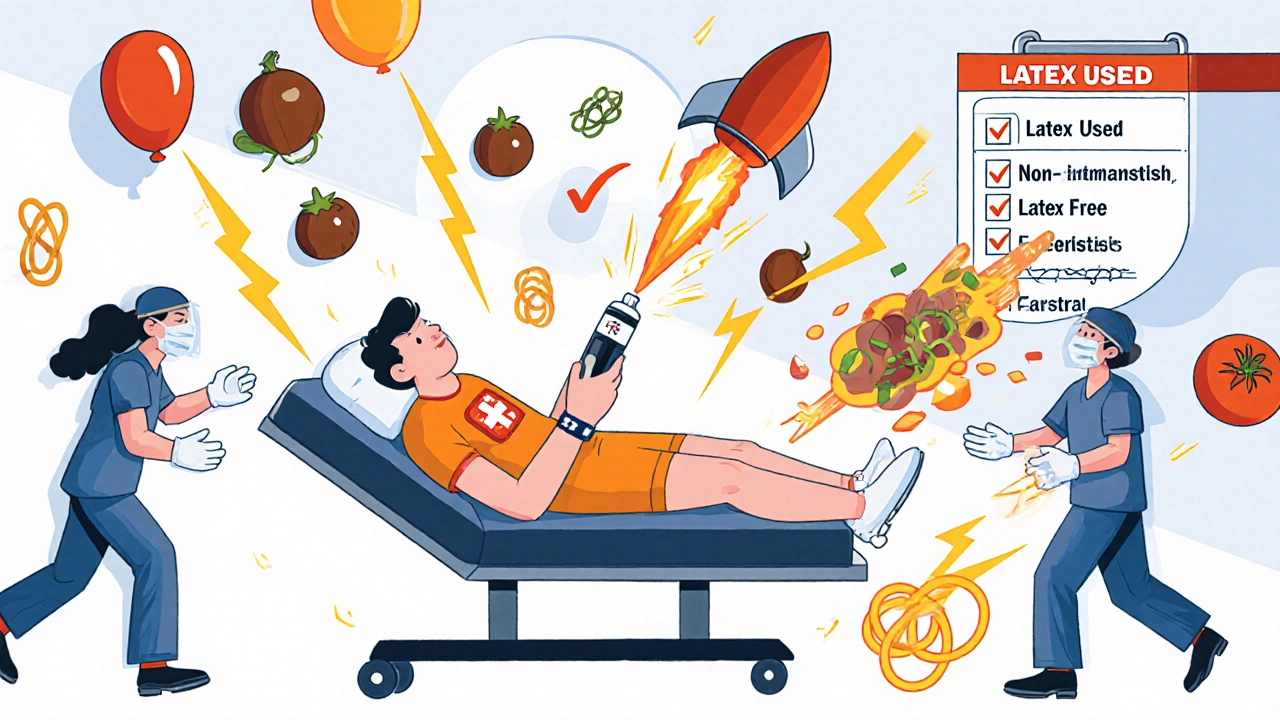What Is Latex Allergy and Why Does It Matter?
Latex allergy isn’t just a skin rash-it’s a real, sometimes life-threatening immune response to proteins in natural rubber latex. These proteins come from the sap of the Hevea brasiliensis tree and are found in gloves, bandages, catheters, and even some balloons or rubber bands. For most people, this isn’t an issue. But for those who are sensitized, even small amounts of latex can trigger reactions ranging from itchy skin to full-blown anaphylaxis.
The problem exploded in the 1980s and 90s when hospitals switched to universal precautions. Suddenly, everyone was wearing latex gloves-doctors, nurses, lab techs, janitors. The result? A surge in allergic reactions. Today, about 1 to 2% of the general population has a latex allergy, but in high-risk groups like healthcare workers or people with spina bifida, the rate jumps to 8-12% and even as high as 67% in some cases.
How Cross-Reactivity Makes Latex Allergy More Complex
One of the most confusing parts of latex allergy is cross-reactivity. Your body doesn’t just react to latex-it can mistake similar proteins in certain foods for the same threat. This means someone allergic to latex might also react to bananas, avocados, kiwis, chestnuts, or even tomatoes. These foods share structural similarities with the allergens in natural rubber latex, so your immune system gets confused.
It’s not a guarantee-only about 30-50% of people with latex allergy experience food cross-reactions. But if you’ve had unexplained itching, swelling, or stomach cramps after eating these foods, and you also react to latex gloves, it’s worth talking to an allergist. There’s no test that can predict cross-reactivity with 100% accuracy, so keeping a food and symptom diary helps identify patterns.
And it’s not just food. Some people with latex allergy also react to certain types of rubber used in toys, shoe soles, or even condoms made from natural rubber. That’s why knowing what to avoid goes beyond gloves.
Who’s at Highest Risk?
Not everyone is equally at risk. The groups most affected are:
- People with spina bifida-due to repeated surgeries and medical procedures early in life, up to two-thirds develop latex allergy. Their mucous membranes absorb latex proteins more easily, making them far more likely to have severe reactions.
- Healthcare workers-especially those in operating rooms, emergency departments, or dialysis units. Regular exposure to powdered latex gloves increases risk dramatically. Studies show that after just five surgeries, a child with spina bifida has a much higher chance of becoming sensitized.
- Workers in manufacturing or cleaning-those who handle latex products regularly, even if not in healthcare, can develop symptoms over time.
- People with other allergies-those already sensitive to pollen or dust mites may be more prone to developing latex allergy.
The longer you’re exposed, the higher your risk. A nurse who’s worn latex gloves daily for 10 years is far more likely to react than someone who only uses them occasionally.
Types of Reactions: Immediate vs. Delayed
Latex allergy comes in two main forms:
- Type I (immediate)-this is IgE-mediated and can be deadly. Symptoms show up within minutes: hives, swelling of the lips or throat, wheezing, drop in blood pressure, or anaphylaxis. This is the kind that requires epinephrine right away.
- Type IV (delayed)-this is contact dermatitis. It’s not life-threatening but still painful. Red, itchy, flaky skin appears 24-48 hours after contact. It’s often mistaken for dry skin or irritation from soap, but it’s an immune response to chemicals added during latex processing.
Many people don’t realize they have a Type I reaction until it’s too late. That’s why it’s critical to know your history. If you’ve ever had sudden swelling after putting on gloves, or felt your throat close up after handling a balloon, don’t ignore it.

Workplace Management: What Employers Must Do
Managing latex allergy at work isn’t optional-it’s a legal and ethical responsibility. In countries like Germany and Finland, banning powdered latex gloves led to an 80% drop in new cases among healthcare workers. That’s not a coincidence. It’s policy working.
Here’s what effective workplace management looks like:
- Switch to non-latex alternatives-nitrile, neoprene, and vinyl gloves are now just as durable and reliable as latex. No more excuses.
- Eliminate powdered gloves entirely-powder carries latex proteins into the air. Inhaling them can trigger asthma or anaphylaxis. Even if you don’t use latex, powder from someone else’s gloves can put you at risk.
- Create a latex-safe zone-designate areas like operating rooms or patient care zones as latex-free. Post signs. Train staff. Make it part of the culture.
- Provide non-latex alternatives for everyone-don’t just accommodate the allergic worker. Offer non-latex gloves to all staff so there’s no stigma, and no accidental exposure.
- Train everyone on recognition and response-staff should know the signs of anaphylaxis and how to use an epinephrine auto-injector. Emergency plans must be posted and practiced.
It’s not just about gloves. Blood pressure cuffs, tourniquets, tubing, and even some masks contain latex. A full audit of all medical supplies is needed. Many hospitals now have latex advisory committees that review every product before purchase.
What Individuals Should Do
If you have a latex allergy, your daily life requires vigilance. Here’s what works:
- Always carry an epinephrine auto-injector-even if you’ve only had mild reactions before. Anaphylaxis can happen suddenly and without warning.
- Wear a medical alert bracelet-this saves lives in emergencies when you can’t speak for yourself.
- Inform everyone-your doctor, dentist, employer, even your hairdresser. Many salon tools and hair extensions contain latex.
- Check labels-latex is in unexpected places: some shoes, elastic waistbands, rubber grips on tools, and even certain baby bottle nipples.
- Use non-latex replacements-silicone, polyurethane, and synthetic rubber are widely available. You don’t have to sacrifice quality.
And don’t rely on “hypoallergenic” labels. That term isn’t regulated. Just because something says it’s gentle doesn’t mean it’s latex-free.
Treatment: What Works When You React
There’s no cure for latex allergy. Avoidance is the only long-term solution. But when reactions happen:
- Anaphylaxis-epinephrine is the first and only line of defense. Inject it immediately. Call 999. Don’t wait. Antihistamines won’t cut it.
- Mild skin reactions-1% hydrocortisone cream and oral antihistamines can help with itching and redness. Avoid scratching-it can worsen the reaction.
- Latex-induced asthma-requires removal from exposure and possibly inhalers. But if you’re still breathing in latex particles at work, your symptoms won’t improve.
Many people try to tough it out. They keep using gloves because they’re cheaper or more comfortable. That’s dangerous. Once you’re sensitized, every exposure makes your immune system more reactive. It’s not a matter of building tolerance-it’s getting worse.

What’s Changed Since the 90s?
Back then, latex gloves were everywhere, and no one thought twice about it. Today, things are better-but not perfect.
Manufacturers now use chlorination to reduce allergen levels and eliminate powder. Many gloves are labeled “low-allergen,” but that doesn’t mean safe for everyone. The best practice is still to avoid latex entirely if you’re allergic.
Some countries have banned powdered latex gloves in healthcare. Others have strict labeling laws. In the UK, while there’s no outright ban, the Health and Safety Executive recommends non-latex alternatives for workers with known allergies. Many NHS trusts now have latex-free policies.
What’s Next?
Researchers are exploring recombinant allergens to improve diagnosis and possibly develop immunotherapy. But those are still years away. Right now, the best tools we have are awareness, avoidance, and emergency preparedness.
Latex allergy is preventable. It’s not curable. And with the right policies and personal habits, it doesn’t have to ruin careers or lives.
Can you outgrow a latex allergy?
No, latex allergy doesn’t go away on its own. Once your immune system recognizes latex proteins as a threat, it remembers them. Avoidance is the only way to prevent reactions. Some people may see fewer symptoms after years without exposure, but the allergy remains. Re-exposure can trigger a stronger reaction.
Are all gloves safe if they’re labeled "non-latex"?
Not always. Some "non-latex" gloves are made from natural rubber derivatives that can still trigger reactions in highly sensitive people. Look for gloves made from nitrile, neoprene, or vinyl-these are the safest options. Always check the material list, not just the label.
Can latex allergy cause asthma?
Yes. Inhaling airborne latex particles-especially from powdered gloves-can trigger asthma symptoms like wheezing, chest tightness, and shortness of breath. This is called occupational asthma. If you develop these symptoms at work and they improve when you’re away, latex exposure is likely the cause.
Should I avoid all fruits if I have a latex allergy?
No. Only avoid fruits that cause you symptoms. Common cross-reactive foods include bananas, avocados, kiwis, chestnuts, and sometimes tomatoes or potatoes. Keep a food diary and test one food at a time under medical supervision. You don’t need to eliminate everything unless you’ve had a reaction.
Is it safe to work in healthcare with a latex allergy?
Yes, if your workplace follows latex-safe protocols. Many healthcare workers with latex allergy continue their careers successfully using non-latex gloves and working in latex-free environments. The key is communication, policy, and access to safe alternatives. If your employer refuses to accommodate you, that’s a violation of workplace safety standards.
Final Thoughts: Prevention Is Possible
Latex allergy doesn’t have to be a career-ender or a daily fear. With the right knowledge, tools, and policies, it’s manageable. Employers who invest in non-latex alternatives protect not just allergic workers-but everyone. Because even if you’re not allergic today, repeated exposure can change that.
Don’t wait for a reaction to happen. If you’re in healthcare, food service, or any field where gloves are routine, ask: Are we using the safest option? Are we training people? Are we ready for an emergency?
Latex allergy is preventable. And prevention starts with awareness-and action.


Comments (8)
Amie Wilde
November 12, 2025 AT 10:25I work in ER and switched to nitrile 3 years ago. No more itchy hands. No more anxiety before shifts. Simple fix, why do some places still use latex?
It’s not that hard.
Gary Hattis
November 13, 2025 AT 21:48Man, I never realized how many things have latex until I started dating someone with the allergy. Turns out my favorite sneakers? Latex glue in the sole. My yoga mat? Latex. Even some condoms I bought "for safety" were a no-go.
Now I read every label like it’s a legal contract. Crazy how something so common can be so dangerous if you’re sensitive. And yeah, the banana thing? Real. Ate one after a glove change and my throat closed up. Scared the hell out of me.
Esperanza Decor
November 15, 2025 AT 21:25I’m a nurse with spina bifida. I’ve had 14 surgeries by age 12. I remember the first time I broke out in hives after a routine checkup. No one knew why. Took years to connect it to gloves.
Now I carry two epinephrine pens. My coworkers know not to hand me anything wrapped in rubber. We have latex-free zones in our unit. It’s not perfect, but it’s something.
And yes, I avoid kiwi like it’s poison. Avocado? Fine. Banana? No. Chestnuts? Nope. My food diary is longer than my medical history.
Deepa Lakshminarasimhan
November 17, 2025 AT 01:24They say it’s about safety. But what if it’s about control? Who benefits from pushing latex? Big Pharma? Glove manufacturers? They made billions off the 90s boom. Now they slap on "low-allergen" labels and call it a day.
Why not just ban it completely? Why force people to ask for accommodations like they’re begging for mercy?
I’ve seen the paperwork. The forms. The "I understand the risks" waivers. That’s not safety. That’s liability laundering.
Erica Cruz
November 17, 2025 AT 06:43Honestly, this post reads like a corporate compliance pamphlet. "Latex allergy is preventable" - yeah, if you’re a wealthy hospital with a budget. What about rural clinics? What about schools? What about the janitor who can’t afford nitrile gloves?
And let’s not pretend people with latex allergies are somehow "special". It’s just another allergy. Stop treating it like a moral crusade. Some people are allergic to peanuts too - do we ban all cookies from workplaces?
Also, "hypoallergenic" isn’t regulated? Newsflash: almost everything in medicine isn’t regulated. Get over it.
Johnson Abraham
November 18, 2025 AT 01:08lol why is everyone so mad about gloves? I mean, if you’re allergic to rubber, maybe just don’t touch stuff? I’ve worn latex gloves for 15 years and never had an issue. Maybe it’s just weak immune systems?
Also, bananas? Really? I eat 3 a day. No problem. Maybe it’s just the new age health cults making stuff up.
btw i use latex gloves and i’m fine 😎
Shante Ajadeen
November 18, 2025 AT 03:04I used to be the person who thought this was overblown. Then my coworker had anaphylaxis in the supply room because someone opened a box of powdered latex gloves nearby.
She was fine - thanks to the epipen we kept in the first aid kit. But I’ll never forget how fast it happened.
Now I make sure every new hire gets the latex safety briefing. I don’t care if it’s "extra". Safety isn’t extra. It’s basic. And if you’re still using powdered gloves in 2025, you’re not being cheap - you’re being reckless.
dace yates
November 19, 2025 AT 13:43I’ve been avoiding latex for 12 years. Still don’t know if I’m allergic to the proteins or the chemicals added during manufacturing. My allergist says it doesn’t matter - avoid both.
But I’ve noticed something: my reactions are worse in dry weather. Humidity seems to reduce airborne particles. I wonder if that’s documented anywhere?